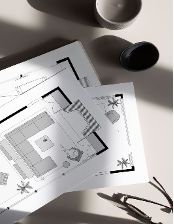Research Potential Designers
Specialization: Look for designers who specialize in commercial spaces similar to yours. Different designers have expertise in various sectors, such as retail, hospitality, or office environments.
Portfolio: Review the portfolios of potential designers to assess their style, quality of work, and experience with similar projects.
Client Testimonials: Check references and read reviews from previous clients to gauge satisfaction and reliability.
Define your brand
defining your business’ core values, brand voice, messaging, marketing, target audience, and ideal client avatar. We say this because your brand is so much more than just a logo. Your brand, simply put, is your promise to your customer.Without strong and consistent brand messaging, values, and visuals, how can you expect your customers/clients to trust you? Without their trust, you don’t get business, which means you don’t make money.Defining your brand directly correlates to your business’ success so, before contacting a designer, ensure you’ve defined your business’ messaging, brand voice, core values, mission, target market, ideal clientele, etc.
Set clear intentions
Before contacting anyone about creating your new or updated visual identity, consider seriously what you need your brand identity to do. Do you want to attract a more wealthy clientele? Get your brand more visibility online or in a particular retail outlet? This will steer the direction for your brand identity and set your designer a clear goal.
Assess Compatibility
Design Aesthetic: Ensure the designer’s style aligns with your vision and brand identity. The designer should be able to translate your ideas into a cohesive and effective design.
Communication: Choose a designer who communicates clearly and listens to your needs. Effective communication is key to a successful collaboration.
Understanding of Your Business: The designer should have a good grasp of your business objectives and how the space will be used.
Check Their Project Management Skills
Coordination: Ensure the designer has strong project management skills to coordinate with other professionals and keep the project on track.
Problem-solving: Assess their ability to handle unexpected issues or changes that may arise during the project.







